Utilitarian and Decorative Objects
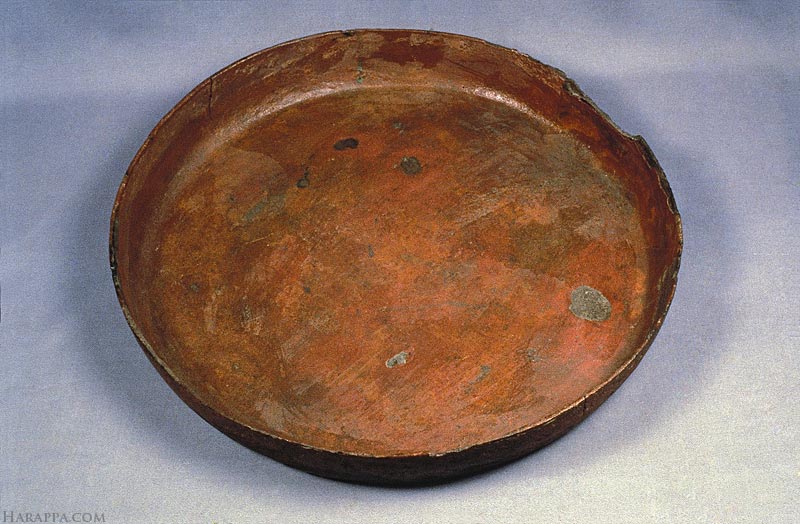 Indus artisans produced a wide range of utilitarian and decorative objects using specialized techniques of stone working, ceramics and metallurgy. Copper and bronze were used to make tools, mirrors, pots and pans (Slide 75 Cooking Vessel, 76 Plate).
Indus artisans produced a wide range of utilitarian and decorative objects using specialized techniques of stone working, ceramics and metallurgy. Copper and bronze were used to make tools, mirrors, pots and pans (Slide 75 Cooking Vessel, 76 Plate).
Bone, shell and ivory were turned into tools, jewelry, gaming pieces and especially furniture inlay. Silver and gold utensils and ornaments (79 Bangles, 81 Necklace) were crafted.
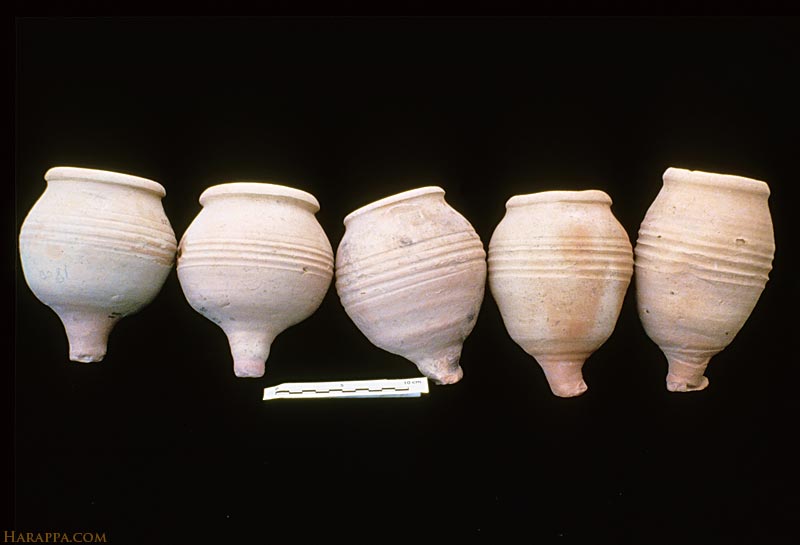 Fine ceramic objects, such as stoneware bangles and glazed faience (82 Ornaments) ornaments were also made. These objects may have been produced for the wealthy merchants and ruling classes, because identical utensils and ornaments were made in terracotta (73 Goblets, 74 Pots, 77 Bangles), probably for ordinary people.
Fine ceramic objects, such as stoneware bangles and glazed faience (82 Ornaments) ornaments were also made. These objects may have been produced for the wealthy merchants and ruling classes, because identical utensils and ornaments were made in terracotta (73 Goblets, 74 Pots, 77 Bangles), probably for ordinary people.
The Indus Script: Seals and Writing
The most unique objects were square seals made of stone and engraved with symbols and animal motifs. The most common animal on the seals is a mythical unicorn (25 Unicorn seal), while other seals are carved with a bull (27 Bull seal), an elephant or even a rhinoceros (37 Mohenjo-daro seals).
Abstract or pictographic symbols that were engraved above the animals represent the Indus form writing (28 Bison seal, 31 Sealing). The presence of writing on seals, as well as on pottery and other objects, indicates that the Indus people had developed a system for recording the names of deities, or people or materials (29 Inscribed objects, 30 Tablets).
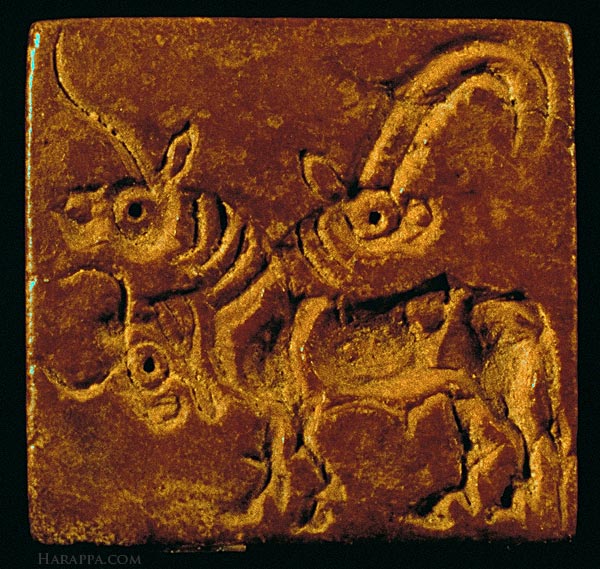 On the average, the inscriptions are very short, consisting of about seven symbols. Scholars have not yet been able to decipher these short inscriptions and will not be able to do so until some longer texts or bi-lingual inscriptions have been discovered.
On the average, the inscriptions are very short, consisting of about seven symbols. Scholars have not yet been able to decipher these short inscriptions and will not be able to do so until some longer texts or bi-lingual inscriptions have been discovered.
Harappan Religion and Belief Systems
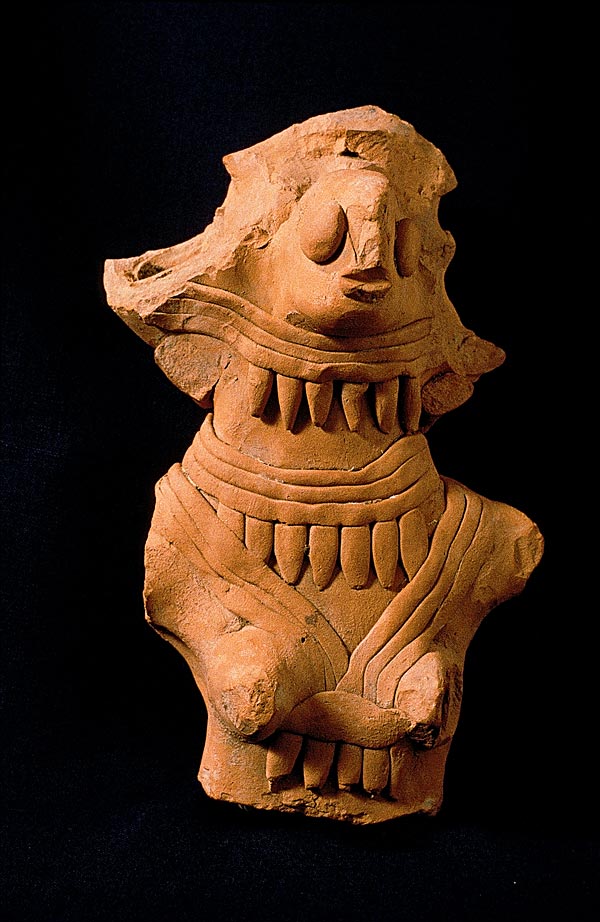 Without the aid of written texts it is difficult to reconstruct the Indus religion. They made clay figurines of animals (45 Male (back), 46 Male, 54 Bull, 56 Bull figurine, 58 Ram, 60 Dog, 61 Tiger, 62 Turtle, 63 Elephant, 64 Monkey, 65 Whistles), men (47 Figurine, 48 Heads, 49 Male figurines) and women (47 Figurines, 50 Female, 51 Female figurine, 52 Females figurines, 53 Replicas) that probably were used in special rituals.
Without the aid of written texts it is difficult to reconstruct the Indus religion. They made clay figurines of animals (45 Male (back), 46 Male, 54 Bull, 56 Bull figurine, 58 Ram, 60 Dog, 61 Tiger, 62 Turtle, 63 Elephant, 64 Monkey, 65 Whistles), men (47 Figurine, 48 Heads, 49 Male figurines) and women (47 Figurines, 50 Female, 51 Female figurine, 52 Females figurines, 53 Replicas) that probably were used in special rituals.
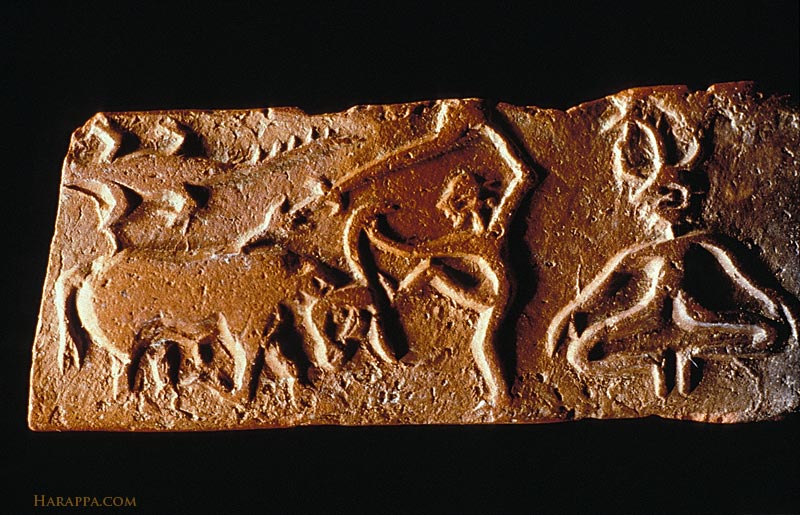 Soft limestone was used to carve small sculptures of deities or important people (39 Male head, 40 Male, 41 Priest King, 42 Priest King (back), 43 Priest King (side), 44 Sculpture, 45 Seated male, 46 Male). Many of the seals have narrative scenes that appear to represent deities and ceremonies (32 Seal, 33 Yogic Seal, 34 Seal Mohenjodaro, 35 Mythical seal, 89 Moulded Tablet, 90 Tablet).
Soft limestone was used to carve small sculptures of deities or important people (39 Male head, 40 Male, 41 Priest King, 42 Priest King (back), 43 Priest King (side), 44 Sculpture, 45 Seated male, 46 Male). Many of the seals have narrative scenes that appear to represent deities and ceremonies (32 Seal, 33 Yogic Seal, 34 Seal Mohenjodaro, 35 Mythical seal, 89 Moulded Tablet, 90 Tablet).
The Indus people buried their dead in wooden coffins along with many pottery vessels (69 to 72), that were probably filled with food for the afterlife. Most individuals, both male and female were buried with some simple ornaments, such as shell or copper bangles and agate beads. Elaborate ornaments of gold, silver and precious stones were never included in the burials and must have been inherited by the living relatives. No royal burials have been found.
